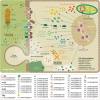Molecular Profiling of Pierce's Disease Outlines the Response Circuitry of Vitis vinifera to Xylella fastidiosa Infection
- PMID: 29937771
- PMCID: PMC6002507
- DOI: 10.3389/fpls.2018.00771
Molecular Profiling of Pierce's Disease Outlines the Response Circuitry of Vitis vinifera to Xylella fastidiosa Infection
Abstract
Pierce's disease is a major threat to grapevines caused by the bacterium Xylella fastidiosa. Although devoid of a type 3 secretion system commonly employed by bacterial pathogens to deliver effectors inside host cells, this pathogen is able to influence host parenchymal cells from the xylem lumen by secreting a battery of hydrolytic enzymes. Defining the cellular and biochemical changes induced during disease can foster the development of novel therapeutic strategies aimed at reducing the pathogen fitness and increasing plant health. To this end, we investigated the transcriptional, proteomic, and metabolomic responses of diseased Vitis vinifera compared to healthy plants. We found that several antioxidant strategies were induced, including the accumulation of gamma-aminobutyric acid (GABA) and polyamine metabolism, as well as iron and copper chelation, but these were insufficient to protect the plant from chronic oxidative stress and disease symptom development. Notable upregulation of phytoalexins, pathogenesis-related proteins, and various aromatic acid metabolites was part of the host responses observed. Moreover, upregulation of various cell wall modification enzymes followed the proliferation of the pathogen within xylem vessels, consistent with the intensive thickening of vessels' secondary walls observed by magnetic resonance imaging. By interpreting the molecular profile changes taking place in symptomatic tissues, we report a set of molecular markers that can be further explored to aid in disease detection, breeding for resistance, and developing therapeutics.
Keywords: Xanthomonadaceae; defense response; metabolome; plant–bacteria interaction; proteome; transcriptome; vascular pathogen.
Figures








Similar articles
-
Water deficit modulates the response of Vitis vinifera to the Pierce's disease pathogen Xylella fastidiosa.Mol Plant Microbe Interact. 2013 Jun;26(6):643-57. doi: 10.1094/MPMI-09-12-0217-R. Mol Plant Microbe Interact. 2013. PMID: 23425100
-
Xylella fastidiosa: an examination of a re-emerging plant pathogen.Mol Plant Pathol. 2018 Apr;19(4):786-800. doi: 10.1111/mpp.12585. Epub 2017 Oct 24. Mol Plant Pathol. 2018. PMID: 28742234 Free PMC article.
-
Xylella fastidiosa Requires the Type II Secretion System for Pathogenicity and Survival in Grapevine.Mol Plant Microbe Interact. 2023 Oct;36(10):636-646. doi: 10.1094/MPMI-03-23-0027-R. Epub 2023 Oct 25. Mol Plant Microbe Interact. 2023. PMID: 37188464
-
Paradigms: examples from the bacterium Xylella fastidiosa.Annu Rev Phytopathol. 2013;51:339-56. doi: 10.1146/annurev-phyto-082712-102325. Epub 2013 May 17. Annu Rev Phytopathol. 2013. PMID: 23682911 Review.
-
The biology of xylem fluid-feeding insect vectors of Xylella fastidiosa and their relation to disease epidemiology.Annu Rev Entomol. 2004;49:243-70. doi: 10.1146/annurev.ento.49.061802.123403. Annu Rev Entomol. 2004. PMID: 14651464 Review.
Cited by
-
Blocking intruders: inducible physico-chemical barriers against plant vascular wilt pathogens.J Exp Bot. 2021 Feb 2;72(2):184-198. doi: 10.1093/jxb/eraa444. J Exp Bot. 2021. PMID: 32976552 Free PMC article.
-
Artificial Intelligence Techniques in Grapevine Research: A Comparative Study with an Extensive Review of Datasets, Diseases, and Techniques Evaluation.Sensors (Basel). 2024 Sep 25;24(19):6211. doi: 10.3390/s24196211. Sensors (Basel). 2024. PMID: 39409251 Free PMC article. Review.
-
Gamma-Aminobutyric Acid Accumulation Contributes to Citrus sinensis Response against 'Candidatus Liberibacter Asiaticus' via Modulation of Multiple Metabolic Pathways and Redox Status.Plants (Basel). 2023 Nov 2;12(21):3753. doi: 10.3390/plants12213753. Plants (Basel). 2023. PMID: 37960112 Free PMC article.
-
Dual RNA Sequencing of Vitis vinifera during Lasiodiplodia theobromae Infection Unveils Host-Pathogen Interactions.Int J Mol Sci. 2019 Dec 3;20(23):6083. doi: 10.3390/ijms20236083. Int J Mol Sci. 2019. PMID: 31816814 Free PMC article.
-
Pierce's Disease of Grapevines: A Review of Control Strategies and an Outline of an Epidemiological Model.Front Microbiol. 2018 Sep 12;9:2141. doi: 10.3389/fmicb.2018.02141. eCollection 2018. Front Microbiol. 2018. PMID: 30258423 Free PMC article. Review.
References
-
- Agüero C. B., Uratsu S. L., Greve C., Powell A. L., Labavitch J. M., Meredith C. P., et al. (2005). Evaluation of tolerance to Pierce’s disease and Botrytis in transgenic plants of Vitis vinifera L. expressing the pear PGIP gene. Mol. Plant Pathol. 6 43–51. 10.1111/j.1364-3703.2004.00262.x - DOI - PubMed
-
- Ardales E. Y., Moon S. J., Park S. R., Shin D., Noh T. H., Byun M. O. (2009). Inactivation of argG, encoding argininosuccinate synthetase from Xanthomonas oryzae pv. oryzae, is involved in bacterial growth and virulence in planta. Can. J. Plant Pathol. 31 368–374. 10.1080/07060660909507611 - DOI
LinkOut - more resources
Full Text Sources
Other Literature Sources

